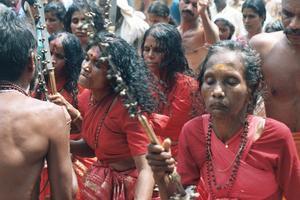Advertisement
Published: March 4th 2006

 Dance in trance
Dance in trance
Pilgrims hack themselves and call out to the goddess as they circle the Kodungallur templeRed and yellow rule the temple courtyard. Red of the customary costumes and the yellow glitter of sabres and anklets, red of blood and yellow of turmeric powder clotting it. Pilgrims-revellers shroud themselves in dust and profanity, ritualistic and rhythmic. On the eve of Bharani, the culmination of the annual festival, Kodungallur temple complex is frenzied.
The vault has been covered after the massacre of chicken. Men and women alike continue to assault themselves with their ornamental sabres. Anointed with blood, they dance in a trance. Pilgrims flood the courtyard in wave after wave. Spectators give way to the perilous runners as a few fall by the wayside. Shining blades and expletives rise over bloody heads.
The week-long festival would culminate the next day when a mass of Velichappads, frenzied and armed oracles, would lay siege to the temple. They would scramble around the temple, flogging its wall and lobbing objects over its roof. They would "pollute" the temple. After Kavu Theendal (polluting the temple), the temple will be closed for a week for "purification".
From Kannaki cult to caste deviations, Kodungallur temple houses many peculiar beliefs and customs. Before Kavu Theendal, non-Brahmins perform a lengthy puja in

 Sharp piety
Sharp piety
Pilgrims with steely resolve and their companions trying to save them circle the Kodungallur templethe temple.
The temple had opened its doors for low-caste Hindus much before a state law enforced it in 1946. For 27 days, anyone could enter the temple without regard to caste or creed.
Women in red, with an anklet and sabre in either hand, remind me of Kannaki, whose anguish and anger burned down the city of Madurai. The protagonist of Ilangovadigal’s Tamil classic Silappathikaram, Kannaki has grown to become a folk cult in south India. From Poompuhar on the eastern coast of India to Kodungallur on the west, she has monuments which bear some kind of her memory.
Kannaki’s husband Kovilan was implicated and executed by the King of Madurai. Kovilan was accused of stealing the queen’s anklets made of precious stones when he was trying to sell off his wife’s equally precious anklet. Kannaki stormed the palace with fire in her eyes and broke the other anklet to reveal the judgment’s fallacy.
Silappathikaram comes from the golden age of Tamil literature, the Sangham age, roughly put in the first six-seven centuries. According to the ballad, Kannki reached Vanchi, the capital of the Cheras, after reducing the Pandya capital to ashes with her curse. Vanchi

 Reliving a cult
Reliving a cult
A young woman in a frenzied mood before the goddess at the Kodungallur templeis believed to be Kodungallur, also known as Musiris when it was a strategic trade port connecting India to Arabia.
Chenkuttuvan, the legendary Chera King who ruled parts of Tamil Nadu and Kerala, built a memorial to Kannaki in his capital in the second century. Myth has it that Kannaki’s mortal remains were kept in the sealed underground vault of the Kodunagallur temple.
Outside, Kannaki look-alikes hack their foreheads with a vengeance as their companions try to block the sabres with short sticks. The deadly ritual goes on. The rhythmic expletives target everyone across the social spectrum - kings, landlords, priests and even the goddess. Experts improvise the lines to include even onlookers. A few years ago, before the law tightened, the show was more organised and imaginative.
Spilling blood, hurling abuses…everything is permitted today. The crude rituals are said to be the legacy of a war between faiths when burgeoning Buddhists fled before the orgainsed onslaught of Hindus. But it could as well be a safety valve in a repressed society.
Advertisement
Tot: 0.046s; Tpl: 0.011s; cc: 8; qc: 23; dbt: 0.0257s; 1; m:domysql w:travelblog (10.17.0.13); sld: 1;
; mem: 1mb

 Dance in trance
Dance in trance
 Sharp piety
Sharp piety
 Reliving a cult
Reliving a cult
